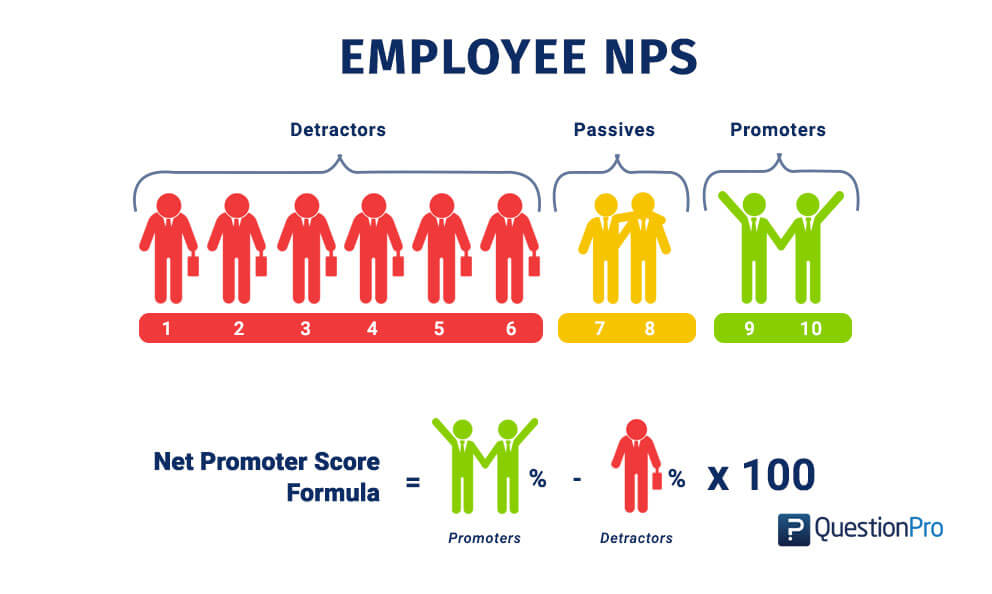What is the best way to measure an employee’s performance, competency and satisfaction, along with strategic alignment with the organization? The answer is employee engagement. But what is the best and easiest way to measure employee engagement? An employee engagement survey. Also known as an employee satisfaction survey.
An employee engagement survey is the best way to track how well or not your employees are performing, and the reason behind the performance. It also helps one think of further strategies to improve employee engagement and employment conditions.
What is employee engagement?
To put it in the simplest of terms, employee engagement is anything that defines the relationship between an employer and an employee. It is a concept based on the tenets of trust and integrity and aims to create work conditions that enable the employees to be at their productive best, thus contributing towards the overall growth of the organization.
A high employee engagement rate indicates happier, more satisfied, and more productive employees, all three factors that are important for an organization’s growth and eventual success.
We wrote an extensive guide on what employee engagement is, recently. You can read it here.
Now the next thing that comes to mind is how do you measure employee engagement. Though there are a few ways to do that, the best and easiest one is conducting an employee engagement survey.
What is an employee engagement survey?
An employee engagement survey is a tool that measures employee satisfaction and the extent to which they feel valued in their company of employment. These surveys aim to find out how the employees feel about the organizational aims and vision, their work conditions and managers, and their own rate of growth.
An employee engagement survey is an effective way to figure out how well are the employees engaged within and with the organization. While engaged employees will be more productive and overall beneficial to the business, the disengaged one will be disgruntled and would bring losses.
Simply put, an employee engagement survey is a way to figure out how every employee can be engaged in a productive manner before things take a negative turn. This often requires putting a careful thought around the questions that would go into the survey.

Now before we start with how to create an employee engagement survey, let’s take a quick look at why it is important.
Why is an employee engagement survey important?
An employee engagement survey or an employee satisfaction survey essentially addresses the following at an organization:
- Being the voice of the employee
- Measuring the engagement level of employees
- Measuring the correlation between employee engagement and organizational growth
- Creating benchmarks for industry comparisons
- Curating ways of increasing employee engagement and productivity
Gauging overall employee satisfaction is imperative to assess whether or not they can contribute to organizational growth. But in addition to that, an employee engagement survey results also help you take the following decisions:
- If an employee is not engaged, can something be done?
- If they cannot be engaged, can they be utilized in another way?
- If they cannot be utilized in another way, should they be let go off?
Employee engagement surveys help answer some of the most difficult questions in a team. However, that is possible only when you’re asking the right questions and when your employee engagement survey has a clearly defined goal.

Let’s give you an overview of what questions you should be including in an employee engagement survey, along with samples and examples.
Employee engagement survey questions you should be asking
Based on our industry research and internal practices, here are a few samples employee engagement survey questions to take a cue from, while creating your own employee satisfaction survey:
A. Employee survey questions about communication
Communication is extremely important within the team and across hierarchies. Lack of communication can lead to serious gaps and distances, leading to an overall deterioration in employee performance and productivity. Thus, the questions should specifically target how an employee is conversing with the superiors and colleagues and if those conversations and being received and reciprocated well.
- Is ideation an easy process for you at your workplace?
- Are your opinions valued within the team?
- Is your manager open enough to consider your suggestions?
- Are you comfortable with your supervisor?
- Does your manager listen to you with the intent to come up with a solution?
- Is the team management transparent?
B. Employee survey questions about the culture
Strong and ethical work culture leads to better-engaged employees. Following are some of the questions to consider while creating employee survey questions about culture:
- Can you remember organizational vision and mission enough to implement it in your individual work policies?
- What are the three words that describe the organization’s culture, according to you?
- Do you think there is a culture of mutual respect in the organization?
- Do you think twice or hesitate before approaching your manager with a grievance or feedback?
- Do you have fun at work?
Another option is to simply use the famous Gallup Q12 employee engagement survey. It is a quick and easy way to set up 12 most crucial questions that can measure your employee engagement in the reliable way and benchmark against the baseline data from Gallup.
C. Open-ended employee engagement survey questions
Some things should be left like loose ends, to be tied by the employees while answering. Open-ended employee engagement survey questions are those. Here are a few examples to get you going:
- What do you think is the greatest strength of the organization?
- What do you think is the biggest weakness of the organization?
- What is that one thing you love about your workplace?
- Is there anything that you would like to change?
- Do you have any suggestions on changing the aforementioned thing?
D. Employee survey questions about job satisfaction
Employee satisfaction is a prerequisite for employee performance and productivity. Thus, there should be a section specifically dedicated to whether or not your employees are feeling satisfied with their current situation, sources, supervisors, and more. Here are a few sample questions that you could include:
- How happy are you here on a scale of 1 to 10?
- Do you think you have your career path charted clearly?
- If you leave the organization now, what would be the reason?
- Is there anything we can do to improve on the aforementioned point?
- Are you happy with the compensation and perks you are receiving?
- Would you join the job again if you get the chance?
- Do you think you have a long and secure future here?
- Do you think your skills are skilfully utilized here?
- How likely are you to recommend a friend or colleague to work here?
E. Employee survey questions about management
This is an extremely crucial aspect. Most of the times, employee disengagement stems from poor management, which further evolves into disinterest in work. Thus, a section should be dedicated to questions about management. Here are a few you should include in your to get you started:
- Do you receive recognition for the work done from your managers?
- What is the frequency of the said recognition?
- Do you feel valued by your manager?
- Are you encouraged to speak up and give suggestions during the team meetings?
- Are your suggestions met with enthusiasm?
- When was the last time you cracked a big project with the efficient guidance of your manager?
F. Employee survey questions about overall wellness
This is a place where many traditional workplaces fail miserably. However, owing to ever-growing awareness about mental health and its impact on overall growth and wellness, this is being acknowledged slowly. A section of the employee engagement survey should be dedicated to employee wellness. Here are a few questions to include:
- Do you think the organization should have a well-defined corporate wellness program?
- Do you think you would participate in wellness workshops and activities?
- Do you think recreational rooms, snack stations, and meditation rooms contribute towards your mental and physical well-being?
- Would you subscribe to any wellness event if that’s started, in-house or outsourced?
- Do you think your job is stressing you out? If yes, why?
- Do you think you are unable to strike a balance between work and life and it is adding on to your stress?
Once you have the employee engagement survey ready, make sure that you have conveyed the importance of participation as well. Let your employees know that you’re not just checking an item off your list and that their opinion matters.
But that’s not all. If you want your employees to participate actively, you need to write these employee engagement survey questions in a way that makes them want to complete it.
You make it too lengthy, they’ll leave it halfway. You make it too complicated, they’ll probably get confused and leave it. You make it short, you’ll probably lose out on what they have to say.
Tips to write good employee engagement survey questions
Assessing the satisfaction level of humans is a difficult task. However, half the deed is done if employee engagement survey questions are created after due analysis and consideration of human psychology – the easier and clearer it is, the more likely we are to participate in it till the point of completion.

Following are some of the best practices for employee engagement surveys to keep in mind while creating these questions:
1. Keep the questions more in number and less in difficulty level
Make sure you ask as many questions as possible, but not very ambiguous or airy ones that add up to the anxiety and confusion of the employee. Remember, the job is to make them open up about their issues and not aggravate those.
2. Give them time to fill up the form
An employee satisfaction survey should not come across as an added task that they’re being pressured to complete. Give them as much time as they need. The more relaxed they are while answering the questions, the more accurate answers you will get, and the better the purpose of the survey will be served.
3. Qualitative and quantitative feedback
Make sure your survey is a mix of all types of questions, across all departments, hierarchies, and issues. Conduct careful and meticulous research while creating the survey. Include both close-ended and open-ended questions to create a holistic approach towards gauging employee grievance and goodness alike. If need be, create two separate employee engagement surveys.
What are the key metrics for employee engagement survey questions?
An employee survey is conducted to gauge employee satisfaction in sync with organizational goals. The answers your employees give should give you a clear indication of the overall employee motivation, employee alignment with organizational goals, employee mood and morale, employee productivity, and employee’s role with and relationship within the respective team.
Here are the key metrics you should measure using your employee engagement survey:
1. Employee net promoter score (ENPS)
ENPS helps you evaluate the loyalty an employee has towards the organization. This includes flexibility to align their goals to the company’s vision and mission. Here’s what the ENPS score means for each employee that participates in your employee engagement survey:

- Less than 6: These employees are less likely to recommend your organization in their network, and are called detractors.
- Between 7 and 8: These are passive employees, that may be good at what they do but are not proactively engaged with your organization.
- Above 8: These are employees who are enthusiastic at the workplace, have a high job satisfaction level, and are more likely to remain loyal to the company. They are also called promoters.
2. Peer relationship metrics
We’re not just talking about being able to have lunch together. Take note of how comfortable your employees feel while reaching out to one another for help or feedback. Also, analyze how many things they refer to as a collective effort. This metric is a clear indicator of how well your employees perform together as a team.
3. Employee participation metrics
When you’re asking open-ended questions, take note of how much value your employees are seeing in the work they do or the opportunities that are being offered to them. The higher the value, the higher is the participation rate. If you see most of your employees’ shying away from becoming a part of something new, it’s indicative of the fact that you need to focus on understanding their needs.
4. Communication metrics
Read between the lines to understand if your employees are communicating well with each other. This should not just be peer to peer communication, but also how openly and how frequently they interact with project managers, department heads and more. If their answers indicate skepticism in making conversation, you need to plan on team bonding activities as ice breakers as soon as possible.
5. Performance metrics
An employee that is more engaged with a company is more likely to do a better job at the company. While analysing the employee engagement survey answers, identify the common bracket in which most of your employees fall based on performance. Are they superstars at what they do? Do they have high potential but are not really performing as well? Or are they all average performers that you need to motivate or enable in some manner?
6. Environment metrics
Look for indications about how your employees feel about the workspace and the overall team culture. Ideally, if they believe you offer an open and high functioning environment where they have the freedom to interact openly and participate in their interest areas, their level of engagement and productivity will be high.
7. Growth metrics
The prospect of growth in a job is what keeps your employees motivated. Your employee engagement survey should answer questions about how the employee feels about their personal growth, whether it is something they expected and what you could do better for them.
8. Satisfaction metrics
When an employee is satisfied with their job and their organization, they tend to take up more ownership of the tasks they’re assigned. This will be reflected in the way they answer questions around their job role, how satisfied they are with it and how they see themselves growing in that role. The more positive they sound, the more satisfied they are.
Do you need to create an employee satisfaction survey?
Understanding employee satisfaction is not an easy task. Each employee is different, with a separate set of strengths and weaknesses. As you grow your team, it is important to focus on each of your team members to enable them to do their best at work. That’s where an employee satisfaction survey and the importance of asking the right employee satisfaction survey questions come in.
Now if you’re wondering how often you need to run these surveys, we have a suggestion. Annual surveys are good, but keep introducing pulse surveys on regular intervals so that you can identify the changes in the workplace in a timely manner!
These surveys, while similar in essence, vary across industries. So please use this guide as a framework to guide your employee engagement survey.
Does your organization have pulse surveys or annual surveys?
Do share the type of employee engagement survey questions and formats you follow with us on Twitter @HarmonizeHQ so that we can learn more from you!



